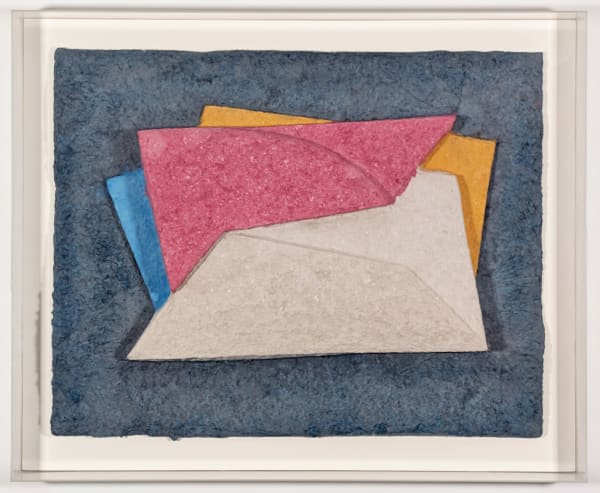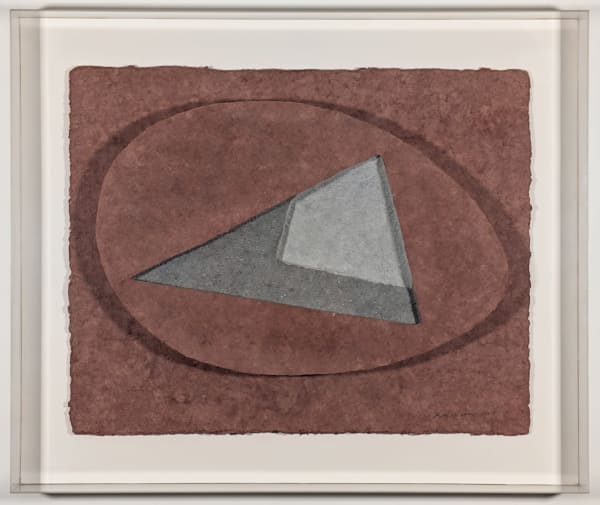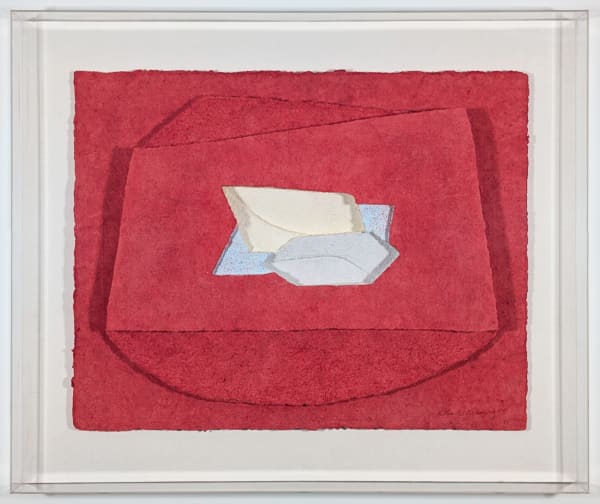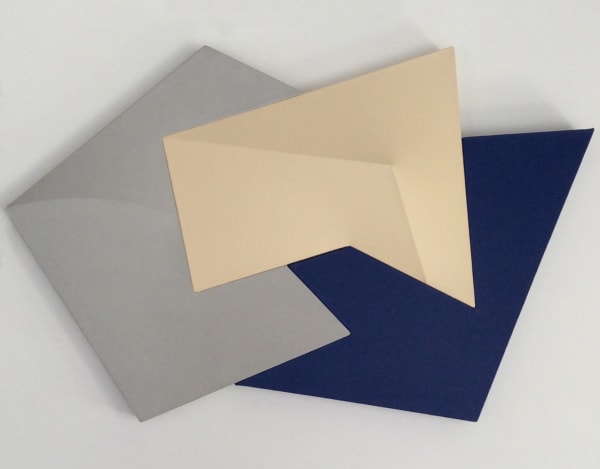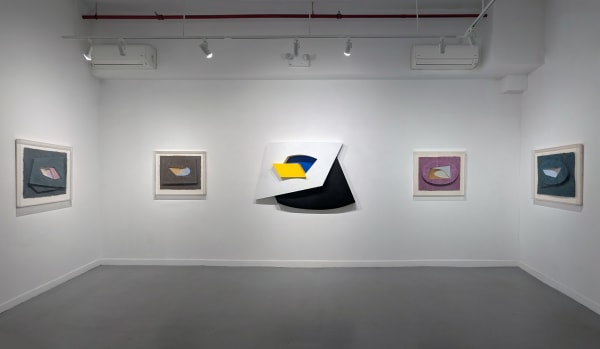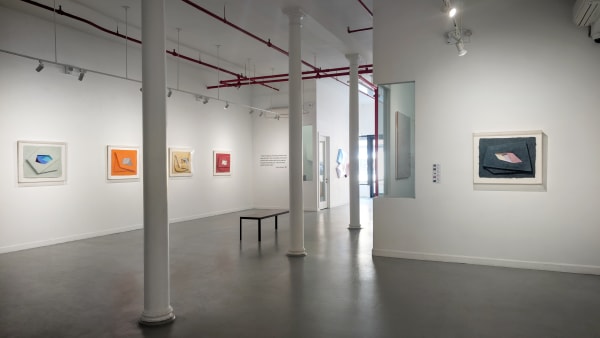Charles Hinman: Paper Matters, 1980s
WESTWOOD GALLERY NYC is pleased to present Paper Matters, an exhibition of nineteen cast paper artworks and three shaped paintings on canvas and wood by New York artist Charles Hinman (b. 1932). Curated by James Cavello, the exhibition is the first survey in three decades devoted to the cast paper constructions created in the early 1980s. The exhibition will be on view from June 20 through August 2, with the opening reception on Thursday, June 19 from 6 to 8 pm.
-
 Charles Hinman, Tula, 1980
Charles Hinman, Tula, 1980 -
 Charles Hinman, Solisucniapa, 1980
Charles Hinman, Solisucniapa, 1980 -
 Charles Hinman, Pisac, 1980
Charles Hinman, Pisac, 1980 -
 Charles Hinman, Hipparchus, 1980
Charles Hinman, Hipparchus, 1980
-
 Charles Hinman, Haravec, 1980
Charles Hinman, Haravec, 1980 -
 Charles Hinman, Mazapan, 1980
Charles Hinman, Mazapan, 1980 -
 Charles Hinman, Calydon, 1980
Charles Hinman, Calydon, 1980 -
 Charles Hinman, Green, 1981
Charles Hinman, Green, 1981
-
 Charles Hinman, Knossos, 1981
Charles Hinman, Knossos, 1981 -
 Charles Hinman, Ore, 1981
Charles Hinman, Ore, 1981 -
 Charles Hinman, Pluto, 1981
Charles Hinman, Pluto, 1981 -
 Charles Hinman, Ridge, 1981
Charles Hinman, Ridge, 1981
-
 Charles Hinman, Rimacpampa, 1980
Charles Hinman, Rimacpampa, 1980 -
 Charles Hinman, Taranto, 1982
Charles Hinman, Taranto, 1982 -
 Charles Hinman, Trieste, 1982
Charles Hinman, Trieste, 1982 -
 Charles Hinman, Udine, 1982
Charles Hinman, Udine, 1982
-
 Charles Hinman: Paper Matters, 1980s | Installation View
Charles Hinman: Paper Matters, 1980s | Installation View -
 Charles Hinman: Paper Matters, 1980s | Installation View
Charles Hinman: Paper Matters, 1980s | Installation View -
 Charles Hinman: Paper Matters, 1980s | Installation View
Charles Hinman: Paper Matters, 1980s | Installation View -
 Charles Hinman: Paper Matters, 1980s | Installation View
Charles Hinman: Paper Matters, 1980s | Installation View -
 Charles Hinman: Paper Matters, 1980s | Installation View
Charles Hinman: Paper Matters, 1980s | Installation View -
 Charles Hinman: Paper Matters, 1980s | Installation View
Charles Hinman: Paper Matters, 1980s | Installation View -
 Charles Hinman: Paper Matters, 1980s | Installation View
Charles Hinman: Paper Matters, 1980s | Installation View -
 Charles Hinman: Paper Matters, 1980s | Installation View
Charles Hinman: Paper Matters, 1980s | Installation View -
 Charles Hinman: Paper Matters, 1980s | Installation View
Charles Hinman: Paper Matters, 1980s | Installation View -
 Charles Hinman: Paper Matters, 1980s | Installation View
Charles Hinman: Paper Matters, 1980s | Installation View -
 Charles Hinman: Paper Matters, 1980s | Installation View
Charles Hinman: Paper Matters, 1980s | Installation View -
 Charles Hinman: Paper Matters, 1980s | Installation View
Charles Hinman: Paper Matters, 1980s | Installation View -
 Charles Hinman: Paper Matters, 1980s | Installation View
Charles Hinman: Paper Matters, 1980s | Installation View -
 Charles Hinman: Paper Matters, 1980s | Installation View
Charles Hinman: Paper Matters, 1980s | Installation View -
 Charles Hinman: Paper Matters, 1980s | Installation View
Charles Hinman: Paper Matters, 1980s | Installation View -
 Charles Hinman: Paper Matters, 1980s | Installation View
Charles Hinman: Paper Matters, 1980s | Installation View
“I enjoy the ambiguous visual dialogue between actual space and illusion. There is play between that which we perceive to be the sculpture object and the imaginary flat plane of the painting space. The one constantly qualifies the other visually.” - Charles Hinman, 1980
WESTWOOD GALLERY NYC is pleased to present an exhibition of nineteen cast paper artworks and three shaped paintings on canvas and wood by New York artist Charles Hinman (b. 1932). Curated by James Cavello, the exhibition is the first survey in three decades devoted to the cast paper constructions created in the early 1980s. The exhibition will be on view from June 20 through August 2, with the opening reception on Thursday, June 19 from 6 to 8 pm.
By the time Charles Hinman moved to New York City at the age of 23, he had earned a degree in Fine Arts from Syracuse University and served as a pitcher for the Milwaukee Braves. Eager to pursue a career in the arts, Hinman enrolled in the Art Students League, where his peers included Morris Kantor, James Rosenquist, and Lee Bontecou. After serving two years in the Army from 1956-58, Hinman returned to New York and moved into Agnes Martin’s former studio, which he shared with James Rosenquist. The studio was located on Coenties Slip, an area on the southern tip of Manhattan, which at the time hosted a community of revolutionary artists including Robert Indiana, Jack Youngerman, Lenore Tawney, Cy Twombly, and Ellsworth Kelly. Entrenched within this vibrant cultural scene, Hinman became a pioneer of the Shaped Canvas and Hard-Edge abstraction movements, exhibiting alongside Shusaku Arakawa, Will Insley, Bob Irwin, Frank Stella, Bob Whitman, and many other minimalist artists.
Hinman’s embrace of color, movement, and sensuousness in his three-dimensional structures distinguished the artist from other Minimalists. Artists like Donald Judd and Robert Morris, for example, preferred an aesthetic of stability, purity, and inertia — qualities Hinman found antithetical to his own ambitions. Hinman soon received critical attention for his paintings as well as early museum acquisitions.
In 1980, Hinman translated this predilection for structural, conceptual, and spatial ambiguity from shaped canvases to a new experimental medium, cast paper. From 1980 to 1983, Hinman collaborated with the fabricator Bummy Huss Paper, Inc. (1979-1993) soon after owner Steven Kasher opened its doors to artists interested in utilizing handmade paper. Comprised entirely of cotton rag, pulped and pigmented with bright hues, and shaped using Styrofoam molds, the cast paper medium presented a new challenge for Hinman to develop the same aesthetics of tension, geometric disunity, and structural use of color explored in his shaped canvases. In 1981, Hinman found himself excited by the constructivist possibilities of paperwork, asserting, "I'm just getting started."
Describing Hinman’s cast paper works in 1996, art critic Donald Kuspit stated, “Hinman has in effect given us two works in one, a macrocosmic and microcosmic abstraction, simultaneously converging and diverging.” Unlike his shaped paintings, Hinman’s cast paper constructions strike balance between calm monochrome fields and drama of central sculptural details. Tinged with a self-aware playfulness, Hinman’s cast paper pieces coyly disrupt the Minimalist tenets of objectivity and detachment from within.
Pairing Hinman’s cast paper series with three paintings on shaped wood and canvas created throughout the 1980s, the exhibition underscores the visual lexicon consistent throughout the artist’s practice. Pagoda (1989), for example, projects the subtle sculptural surfaces within Hinman’s cast paper reliefs onto an expansive shaped wood base. The synchronicities across Hinman’s oeuvre and across his varying media guide the viewer in absorbing the artist’s conceptions of space, light, and illusion.
As Westwood Gallery NYC enters its third decade, Curator James Cavello endeavors to shed light on the stories of artists whose real impact on our cultural evolution has flown under the art-historical radar. While Charles Hinman is a key figure in the history of Minimalism and Shaped Paintings in New York City, his cast paper works are often overshadowed by his large projecting canvases. In his fourth solo exhibition at the gallery, the stage is given to these extraordinary works of art, which manifest Hinman’s legendary artistic vision in a new dimension.
_______________________
Charles Hinman (b. 1932) is a New York Minimal painter who pioneered three-dimensional shaped canvas paintings through his innovative use of shadow, light, and shape with complex mathematical formulae. Born and raised in Syracuse, New York, Hinman holds his BFA from Syracuse University and taught at the Arts Student League of New York. In 1965, he joined the growing community of artists on the Bowery and moved into his studio and living space at 231A Bowery in the same building with artists Will Insley, David Diao, Tom Wesselmann, Frances Barth, Harvey Quaytman, and Max Gimblett, where Hinman resided for over fifty years.
Charles Hinman's artwork is exhibited internationally and collected by major institutions and private collectors across the world. His work is included in the permanent collections of the Whitney Museum of American Art, the Museum of Modern Art, the Los Angeles County Museum of Art, the Hirshhorn Museum and Sculpture Garden, the Denver Art Museum, the Nagaoka Museum in Japan, and the Tel Aviv Museum in Israel, among others. He is the recipient of a Guggenheim Fellowship and four Pollock-Krasner Foundation grants. His most recent retrospective was in 2019 at the Kreeger Museum, Washington DC. Charles Hinman is exclusively represented by Westwood Gallery NYC acting as sole trustee of the Charles Hinman Artwork Trust.




